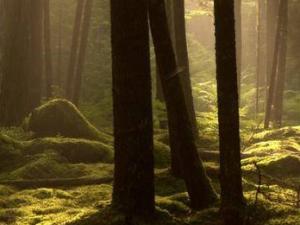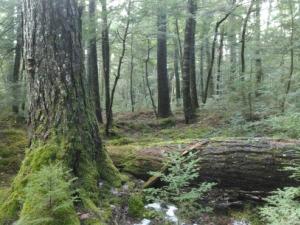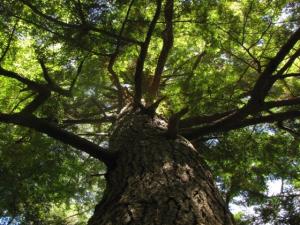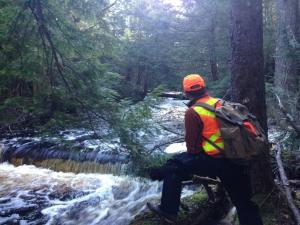Eastern Hemlock
The Eastern hemlock (Tsuga canadensis) is a coniferous tree native to Eastern North America. It is conical in shape, with a wide trunk tapering at the top and drooping branches. The bark is scaly when young and deeply furrowed as the tree ages. The 1-2 cm needles are shiny green on top and pale underneath. The oval shaped cones are 12-20 mm long.
A Foundational Species
Eastern hemlock is a foundational species which performs unique ecological functions and creates its own environmental conditions. Dense shade cast by hemlock regulates the temperature of understories and provides protection from harsh weather. Low hemlock transpiration (compared to hardwoods), and its cooling effects maintain a more stable hydrology. Slow decomposition of hemlock needles regulates soil nutrient cycling processes and supports unique biota, including fungi and insects.
Massive and Majestic Old-Growth
Old-growth forests provide more stable environments than young forests, and support ecosystem services by allowing for greater moisture retention and carbon sequestration. They have higher genetic diversity than young forests and are more resilient to impacts from climate change or disease. Old-growth forests also support greater biodiversity by providing unique habitat for sensitive or specialized mosses, lichens, fungi, bacteria, insects, birds, and mammals. Due primarily to human disturbance, less than 1% of Nova Scotia’s forests are over one hundred years old; of these old forests, many are hemlock dominant.
Spiritual and Indigenous Values
"An old-growth hemlock forest is a place of inspiration, a place to regain serenity and equilibrium." -Martin Buber
Hemlock stands provide many social and cultural values, including the use of bark to make dyes and traditional medicine to treat a variety of ailments. With their unique aesthetic appeal, hemlock stands provide humans with a sense of spiritual connection and wellbeing and support a range of recreation activities.
Aquatic Habitat Integrity and Wildlife Habitat
Hemlock stands provide valuable wildlife cover and maintain aquatic habitat integrity on brooks, streams and rivers. Hemlock cover may provide wintering areas for deer and moose, offering shallower snow depths and shelter from harsh weather. Multi-layered canopies in hemlock stands also provide habitat for birds such as the black-throated green warbler, blackburnian warbler, and the Acadian flycatcher. Brook trout habitat is supported by cool, shaded streams under dense hemlock canopies.
Ecosystem Services
Like other tree species, hemlocks provide ecosystem services by reducing storm-water runoff, controlling erosion, regulating temperature, reducing wind exposure, absorbing pollution, producing oxygen, storing carbon dioxide, and providing habitat. While some functions may be permanently reduced or lost following increased hemlock mortality, some ecosystem services will eventually be compensated by other tree species.






